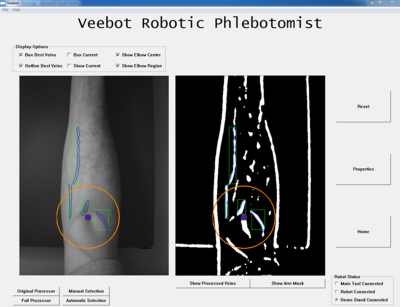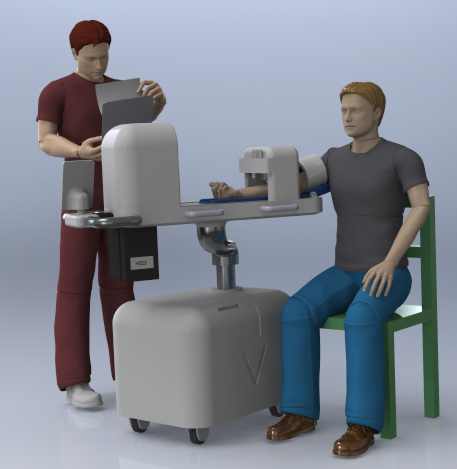| A Robot With A Hypodermic Needle |
| Written by Lucy Black | |||
| Saturday, 27 July 2013 | |||
|
Would you let a robot take your blood? The answer to this question illuminates our real relationship to machines that aspire to rise above the robot vac. Is there another sort of uncanny valley? Veebot is a very clever use of some basic image processing plus some very accurate positioning mechanisms. It first locates a good vein using infrared. Once it has a target it switches to ultrasound to make sure that there is enough blood flow to make it worth inserting the needle. There are many conditions which make it difficult for a human phlebotomist to locate a vein and finding a suitable vein is always a matter of probability. Veebot isn't about making drawing blood or inserting IVs less painful, nor it is about saving manual labour - currently at least there has to be a human supervisor. It is about getting it right first time and actually getting a blood sample. For difficult patients this does indeed reduce the amount of pain because it eliminates repeated attempts to find a vein.
Even if you find the explanation of what is going on at the technical level satisfying, I would still urge you to watch the video to discover something interesting about your relationship with the technology. See it in action and discover your reaction -with apologies for the very strange voice over:
So did you find it "creepy"? I did and so far I haven't found anyone who admits to being 100% relaxed about the idea. This is very strange because it is clear that the human technician is basically working blind, so our emotional response is saying "yes I'd rather be a semi random dart board than allow a highly accurate single jab". The reasons, and you will have to introspect to see if this applies to you, seem to be something to do with the lack of communication and a power inequality. If a phlebotomist is getting it wrong you can make "ow" noises to tell them to back off a bit. The robot doesn't respond to human pain sounds. Then there is the small matter that this large lump of metal looks as if it could remove your arm if it went wrong. While I've encountered some frightening phlebotomists I can't say any had quite the power of steel and motors. Apart from the basic panic reaction that many people suffer when faced with a needle, there do seem to be real concerns about putting your arm in a machine like this. So why not just have a big "STOP" switch that the patient can press? Surely this would settle the mind? Well it would if the effectiveness of the switch was obvious. If you say to the phlebotomist "stop!" then you would expect them, unless they were deaf or deranged, to stop. Now compare this to the big red stop button. How do you know that the machine will obey the off command. This is of course the standard plot device used in so many sci-fi stories and movies and it all hinges on the lack of transparent control, a situation software makes much worse. This seems to be another sort of uncanny valley. The machine just isn't intelligent enough to interact with us humans in a way that makes it reasonable to assume that it is controllable. If it was a simpler machine, you could see how to unplug it with some confidence. If it was a much more intelligent machine, you would be taken in by its empathy into believing that it would obey you if it was hurting you. The problem is that this machine is only clever in the image processing sense - it knows far too little about humans and pain. So you are probably right to feel creeped out by it. A much better solution would be to give phlebotomists control of the system. Let them use the image processing to locate a vein and then let them stick in the needle. See how much better that scenario feels - unless you are needle phobic of course in which case it feels no better at all...
More InformationRelated ArticlesRobot With "Human" Body Is Well Into The Uncanny Valley Inflatable Robots - Safe and a Lot of Fun! Korean Household Robot Prepares Salad DARPA'S ATLAS Robot Needs A Brain
To be informed about new articles on I Programmer, install the I Programmer Toolbar, subscribe to the RSS feed, follow us on, Twitter, Facebook, Google+ or Linkedin, or sign up for our weekly newsletter.
Comments
or email your comment to: comments@i-programmer.info
|
|||
| Last Updated ( Saturday, 27 July 2013 ) |



